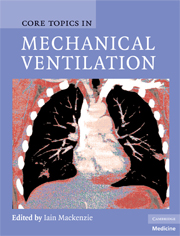Book contents
- Frontmatter
- Contents
- Contributors
- Foreword
- Preface
- Introductory Notes
- 1 Physiology of ventilation and gas exchange
- 2 Assessing the need for ventilatory support
- 3 Oxygen therapy, continuous positive airway pressure and non-invasive ventilation
- 4 Management of the artificial airway
- 5 Modes of mechanical ventilation
- 6 Oxygenation
- 7 Carbon dioxide balance
- 8 Sedation, paralysis and analgesia
- 9 Nutrition in the mechanically ventilated patient
- 10 Mechanical ventilation in asthma and chronic obstructive pulmonary disease
- 11 Mechanical ventilation in patients with blast, burn and chest trauma injuries
- 12 Ventilatory support: extreme solutions
- 13 Heliox in airway obstruction and mechanical ventilation
- 14 Adverse effects and complications of mechanical ventilation
- 15 Mechanical ventilation for transport
- 16 Special considerations in infants and children
- 17 Tracheostomy
- 18 Weaning, extubation and de-cannulation
- 19 Long-term ventilatory support
- 20 The history of mechanical ventilation
- Glossary
- Index
20 - The history of mechanical ventilation
Published online by Cambridge University Press: 14 October 2009
- Frontmatter
- Contents
- Contributors
- Foreword
- Preface
- Introductory Notes
- 1 Physiology of ventilation and gas exchange
- 2 Assessing the need for ventilatory support
- 3 Oxygen therapy, continuous positive airway pressure and non-invasive ventilation
- 4 Management of the artificial airway
- 5 Modes of mechanical ventilation
- 6 Oxygenation
- 7 Carbon dioxide balance
- 8 Sedation, paralysis and analgesia
- 9 Nutrition in the mechanically ventilated patient
- 10 Mechanical ventilation in asthma and chronic obstructive pulmonary disease
- 11 Mechanical ventilation in patients with blast, burn and chest trauma injuries
- 12 Ventilatory support: extreme solutions
- 13 Heliox in airway obstruction and mechanical ventilation
- 14 Adverse effects and complications of mechanical ventilation
- 15 Mechanical ventilation for transport
- 16 Special considerations in infants and children
- 17 Tracheostomy
- 18 Weaning, extubation and de-cannulation
- 19 Long-term ventilatory support
- 20 The history of mechanical ventilation
- Glossary
- Index
Summary
Prehistory
The essential connection between breathing and life has been recognized since biblical times at least:
… the Lord God formed the man from the dust of the ground and breathed into his nostrils the breath of life, and the man became a living being.
The importance of a clear airway in permitting breathing has also long been appreciated. There are, for example, possible illustrations of therapeutic tracheostomy in ancient Egyptian tablets dating from the First Dynasty (3600 BC) and the procedure is also mentioned in a book of Hindu medicine, the Rig Veda, which may have been written as early as 2000 BC.
Some authors have interpreted a passage from the Old Testament as a description of artificial expired air ventilation:
…And he went up and lay upon the child, and put his mouth upon his mouth, and his eyes upon his eyes, and his hands upon his hands: and he stretched himself upon the child; and the flesh of the child waxed warm …and the child opened his eyes …
However, clear evidence of forced tidal ventilation as a means of sustaining or restoring life is lacking until the mid-sixteenth century when Andreas Vesalius (Figure 20.1), the Brussels-born anatomist and professor of medicine at Padua, clearly describes expired air ventilation through an intratracheal reed to keep a dog alive:
But that life may in a manner of speaking be restored to the animal, an opening must be attempted in the trunk of the trachea, into which a tube of reed or cane should be put; you will then blow into this, so that the lung may arise again and the animal take in air.
Keywords
- Type
- Chapter
- Information
- Core Topics in Mechanical Ventilation , pp. 388 - 403Publisher: Cambridge University PressPrint publication year: 2008

